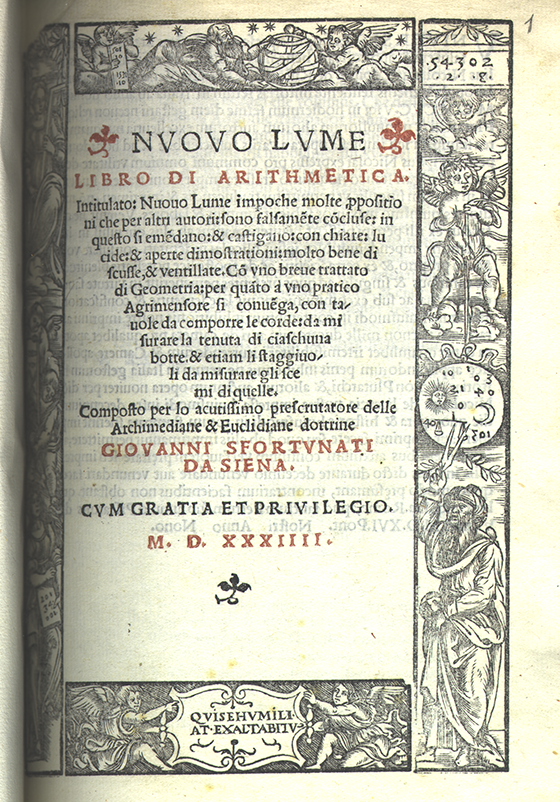- About MAA
- Membership
- MAA Publications
- Periodicals
- Blogs
- MAA Book Series
- MAA Press (an imprint of the AMS)
- MAA Notes
- MAA Reviews
- Mathematical Communication
- Information for Libraries
- Author Resources
- Advertise with MAA
- Meetings
- Competitions
- Programs
- Communities
- MAA Sections
- SIGMAA
- MAA Connect
- Students
- MAA Awards
- Awards Booklets
- Writing Awards
- Teaching Awards
- Service Awards
- Research Awards
- Lecture Awards
- Putnam Competition Individual and Team Winners
- D. E. Shaw Group AMC 8 Awards & Certificates
- Maryam Mirzakhani AMC 10 A Awards & Certificates
- Two Sigma AMC 10 B Awards & Certificates
- Jane Street AMC 12 A Awards & Certificates
- Akamai AMC 12 B Awards & Certificates
- High School Teachers
- News
You are here
Mathematical Treasure: Popular Italian Arithmetic
Giovanni Sfortunati (fl. 1500) of Siena first published Nuovo lume / Libro di arithmetica in 1534 in Venice. It was based on the works of Pacioli (1494), Calandri (1491), and Borghi (1484). However, Sfortunati considered them to contain too much that was not useful for merchants and to not explain elementary notions well enough to be truly useful for beginners. His book was to be more user-friendly. This brief arithmetic was popular and in use for many years.

The image above was obtained through the courtesy of the Erwin Tomash Library on the History of Computing, Charles Babbage Institute, University of Minnesota. A digitization of a 1544 printing is available from Biblioteca Europea di Informazione e Cultura.
Erwin Tomash (1921–2012) was a pioneering computer scientist, helping launch the U.S. computer industry from the 1940s onward. During the 1970s he became interested in the history of computer science, and founded the Charles Babbage Society, and its research arm, the Charles Babbage Institute. The Institute, an archive and research center, is housed at the University of Minnesota. Its Erwin Tomash Library on the History of Computing began with Tomash's 2009 donation to the Institute of much of his own collection of rare books from the history of mathematics and computing. (Source: Jeffrey R. Yost, Computer Industry Pioneer: Erwin Tomash (1921-2012), IEEE Annals of the History of Computing, April-June 2013, 4–7.)
Frank J. Swetz (The Pennsylvania State University), "Mathematical Treasure: Popular Italian Arithmetic," Convergence (August 2018)




